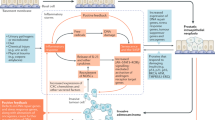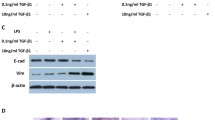Abstract
Benign prostatic hyperplasia (BPH) is the most common proliferative disease of the prostate of men in the United States. The histopathology of BPH strongly implicates local paracrine and autocrine growth factors and inflammatory cytokines in its pathogenesis. A complex milieu of growth-regulatory proteins includes members of the fibroblast, insulin-like, and transforming growth factor families. It appears that these proteins and downstream effector molecules, in addition to a variety of interleukins, are overexpressed in BPH and, working together, create a landscape of increased stromal and epithelial growth and mesenchymal transdifferentiation that leads to disease progression. Inflammation, commonly present in BPH, may contribute to tissue injury, and cytokines produced by inflammatory cells may serve to drive local growth factor production and angiogenesis in the tissues as a “wound healing” response. As we begin to unravel the precise mechanisms involved, new treatments for BPH aimed at these interacting pathways may emerge.
Similar content being viewed by others
References and Recommended Reading
Berry SJ, Coffey DS, Walsh PC, et al.: The development of human benign prostatic hyperplasia with age. J Urol 1984, 132:474–479.
Kirby RS: The natural history of benign prostatic hyperplasia: what have we learned in the last decade? Urology 2000, 56:3–6.
Lee C, Kozlowski JM, Grayhack JT: Intrinsic and extrinsic factors controlling benign prostatic growth. Prostate 1997, 31:131–138.
McNeal J: Pathology of benign prostatic hyperplasia: insight into etiology. Urol Clin North Am 1990, 17:477–486.
Bierhoff E, Walljasper U, Hofmann D, et al.: Morphological analogies of fetal prostate stroma and stromal nodules in BPH. Prostate 1997, 31:234–240.
Giri D, Ropiquet F, Ittmann M: Alterations in expression of basic fibroblast growth factor (FGF) 2 and its receptor FGFR-1 in human prostate cancer. Clin Cancer Res 1999, 5:1063–1071.
Ropiquet F, Giri D, Lamb DJ, et al.: FGF7 and FGF2 are increased in benign prostatic hyperplasia and are associated with increased proliferation. J Urol 1999, 162:595–599.
Nishi N, Matuo Y, Muguruma Y, et al.: A human prostatic growth factor (hPGF): partial purification and characterization. Biochem Biophys Res Commun 1985, 132:1103–1109.
Ittman M, Mansukhani A: Expression of fibroblast growth factors (FGFs) and FGF receptors in human prostate. J Urol 1997, 157:351–356.
Boget S, Cereser C, Parvaz P, et al.: Fibroblast growth factor receptor 1 (FGFR1) is over-expressed in benign prostatic hyperplasia whereas FGFR2-IIIc and FGFR3 are not. Eur J Endocrinol 2001, 145:303–310.
Muller WJ, Lee FS, Dickson C, et al.: The int-2 gene product acts as an epithelial growth factor in transgenic mice. EMBO J 1990, 9:907–913.
Saez C, Gonzalez-Baena AC, Japon MA, et al.: Expression of basic fibroblast growth factor and its receptors FGFR1 and FGFR2 in human benign prostatic hyperplasia treated with finasteride. Prostate 1999, 40:83–88.
De Bellis A, Crescioli C, Grappone C, et al.: Expression and cellular localization of keratinocyte growth factor and its receptor in human hyperplastic prostate tissue. J Clin Endocrinol Metab 1998, 83:2186–2191.
Planz B, Aretz HT, Wang Q, et al.: Immunolocalization of the keratinocyte growth factor in benign and neoplastic human prostate and its relation to androgen receptor. Prostate 1999, 41:233–242.
Huang YW, Wang LS, Chang HL, et al.: Effect of keratinocyte growth factor on cell viability in primary cultured human prostate cancer stromal cells. J Steroid Biochem Mol Biol 2006, 100:24–33.
Giri D, Ropiquet F, Ittmann M: FGF9 is an autocrine and paracrine prostatic growth factor expressed by prostatic stromal cells. J Cell Physiol 1999, 180:53–60.
Cohen P, Peehl DM, Lamson G, et al.: Insulin-like growth factors (IGFs), IGF receptors, and IGF-binding proteins in primary cultures of prostatic epithelial cells. J Clin Endocrinol Metab 1991, 73:401–407.
Monti S, Di Silverio F, Iraci R, et al.: Regional variations of insulin-like growth factor I (IGF-I), IGF-II, and receptor type 1 in benign prostatic hyperplasia tissue and their correlation with intraprostatic androgens. J Clin Endocrinol Metab 2001, 86:1700–1706.
Luo J, Dunn T, Ewing C, et al.: Gene expression signature of benign prostatic hyperplasia revealed by cDNA microarray analysis. Prostate 2002, 51:189–200.
Dong G, Roopmathy R, Vu T, et al.: Decreased expression of Wilm’s tumor gene WT-1 and elevated expression of insulin growth factor-II (IGF-II) and type 1 IGF receptor genes in prostatic stromal cells from patients with benign prostatic hyperplasia. J Clin Endocrinol Metab 1997, 82:2198–2203.
Grant ES, Ross MB, Ballard S, et al.: The insulin-like growth factor type I receptor stimulates growth and suppresses apoptosis in prostatic stromal cells. J Clin Endocrinol Metab 1998, 83:3252–3257.
Boudon C, Rodier G, Lechevallier E, et al.: Secretion of insulin-like growth factors and their binding proteins by human normal and hyperplastic prostatic cells in primary culture. J Clin Endocrinol Metab 1996, 81:612–617.
Cohen P, Peehl DM, Baker B, et al.: Insulin-like growth factor axis abnormalities in prostatic stromal cells from patients with benign prostatic hyperplasia. J Clin Endocrinol Metab 1994, 79:1410–1415.
Thomas LN, Wright AS, Lazier CB, et al.: Prostatic involution in men taking finasteride is associated with elevated levels of insulin-like growth factor-binding proteins (IGFBPs)-2,-4, and-5. Prostate 2000, 42:203–210.
Royuela M, De Miguel MP, Bethencourt FR, et al.: Transforming growth factor beta 1 and its receptor types I and II: comparison in human normal prostate, benign prostatic hyperplasia, and prostatic carcinoma. Growth Factors 1998, 16:101–110.
Klingler HC, Bretland AJ, Reid SV, et al.: Regulation of prostatic stromal cell growth and function by transforming growth factor beta (TGFbeta). Prostate 1999, 41:110–120.
Mori H, Maki M, Oishi K, et al.: Increased expression of genes for basic fibroblast growth factor and transforming growth factor type beta 2 in human benign prostatic hyperplasia. Prostate 1990, 16:71–80.
Peehl DM, Sellers RG: Induction of smooth muscle cell phenotype in cultured human prostatic stromal cells. Exp Cell Res 1997, 232:208–215.
Tuxhorn JA, Ayala GE, Smith MJ, et al.: Reactive stroma in human prostate cancer: induction of myofibroblast phenotype and extracellular matrix remodeling. Clin Cancer Res 2002, 8:2912–2923.
Untergasser G, Gander R, Lilg C, et al.: Profiling molecular targets of TGF-beta1 in prostate fibroblastto-myofibroblast transdifferentiation. Mech Ageing Dev 2005, 126:59–69.
Fukabori Y, Nakano K, Ohyama A, et al.: Stimulative effect of transforming growth factor-beta on collagen synthesis by human prostatic stromal cells in vitro. Int J Urol 1997, 4:597–602.
Kakehi Y, Segawa T, Wu XX, et al.: Down-regulation of macrophage inhibitory cytokine-1/prostate derived factor in benign prostatic hyperplasia. Prostate 2004, 59:351–356.
Taoka R, Tsukuda F, Ishikawa M, et al.: Association of prostatic inflammation with down-regulation of macrophage inhibitory cytokine-1 gene in symptomatic benign prostatic hyperplasia. J Urol 2004, 171:2330–2335.
Jackson MW, Bentel JM, Tilley WD: Vascular endothelial growth factor (VEGF) expression in prostate cancer and benign prostatic hyperplasia. J Urol 1997, 157:2323–2328.
Doll JA, Reiher FK, Crawford SE, et al.: Thrombospondin-1, vascular endothelial growth factor and fibroblast growth factor-2 are key functional regulators of angiogenesis in the prostate. Prostate 2001, 49:293–305.
Soulitzis N, Karyotis I, Delakas D, et al.: Expression analysis of peptide growth factors VEGF, FGF2, TGFB1, EGF and IGF1 in prostate cancer and benign prostatic hyperplasia. Int J Oncol 2006, 29:305–314.
Nickel JC, Downey J, Young I, et al.: Asymptomatic inflammation and/or infection in benign prostatic hyperplasia. BJU Int 1999, 84:976–981.
Steiner G, Gessl A, Kramer G, et al.: Phenotype and function of peripheral and prostatic lymphocytes in patients with benign prostatic hyperplasia. J Urol 1994, 151:480–484.
Lee KL, Peehl DM: Molecular and cellular pathogenesis of benign prostatic hyperplasia. J Urol 2004, 172:1784–1791.
Kramer G, Steiner GE, Handisurya A, et al.: Increased expression of lymphocyte-derived cytokines in benign hyperplastic prostate tissue, identification of the producing cell types, and effect of differentially expressed cytokines on stromal cell proliferation. Prostate 2002, 52:43–58.
Konig JE, Senge T, Allhoff EP, et al.: Analysis of the inflammatory network in benign prostate hyperplasia and prostate cancer. Prostate 2004, 58:121–129.
Giri D, Ittmann M: Interleukin-8 is a paracrine inducer of fibroblast growth factor 2, a stromal and epithelial growth factor in benign prostatic hyperplasia. J Pathol 2001, 159:139–147.
Castro P, Xia C, Gomez L, et al.: Interleukin-8 expression is increased in senescent prostatic epithelial cells and promotes the development of benign prostatic hyperplasia. Prostate 2004, 60:153–159.
Penna G, Mondaini N, Amuchastegui S, et al.: Seminal plasma cytokines and chemokines in prostate inflammation: interleukin 8 as a predictive biomarker in chronic prostatitis/chronic pelvic pain syndrome and benign prostatic hyperplasia. Eur Urol 2007, 51:524–533.
Steiner GE, Newman ME, Paikl D, et al.: Expression and function of pro-inflammatory interleukin IL-17 and IL-17 receptor in normal, benign hyperplastic, and malignant prostate. Prostate 2003, 56:171–182.
Albini A, Tosetti F, Benelli R, et al.: Tumor inflammatory angiogenesis and its chemoprevention. Cancer Res 2005, 65:10637–10641.
Chen Y, Du XY: Functional properties and intercellular signaling of CCN1/Cyr61. J Cell Biochem 2006, Dec 14 [Epub ahead of print].
Sakamoto S, Yokoyama M, Zhang X, et al.: Increased expression of Cyr61, an extracellular matrix signaling protein, in human benign prostatic hyperplasia and its regulation by lysophosphatidic acid. Endocrinology 2004, 145:2929–2940.
Sakamoto S, Yokoyama M, Aoki M, et al.: Induction and function of Cyr61 (CCN1) in prostatic stromal and epithelial cells: Cyr61 is required for prostatic cell proliferation. Prostate 2004, 61:305–317.
Prakash K, Pirozzi G, Elashoff M, et al.: Symptomatic and asymptomatic benign hyperplasia: molecular differentiation by using microarrays. Proc Natl Acad Sci U S A 2002, 99:7598–7603.
Author information
Authors and Affiliations
Corresponding author
Rights and permissions
About this article
Cite this article
Scott Lucia, M., Lambert, J.R. Growth factors in benign prostatic hyperplasia: Basic science implications. Curr Urol Rep 9, 272–278 (2008). https://doi.org/10.1007/s11934-008-0048-6
Published:
Issue Date:
DOI: https://doi.org/10.1007/s11934-008-0048-6




